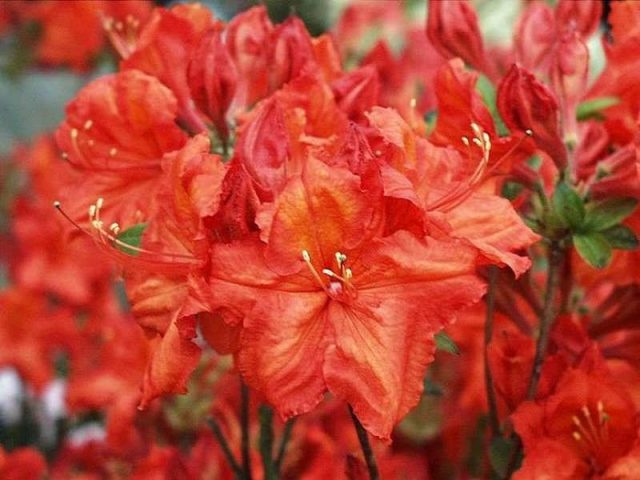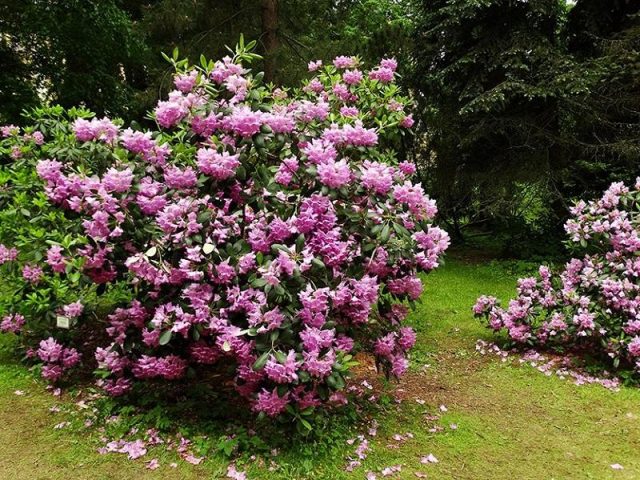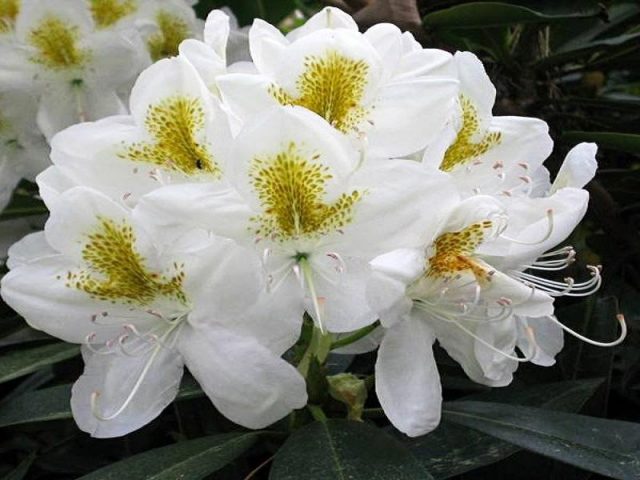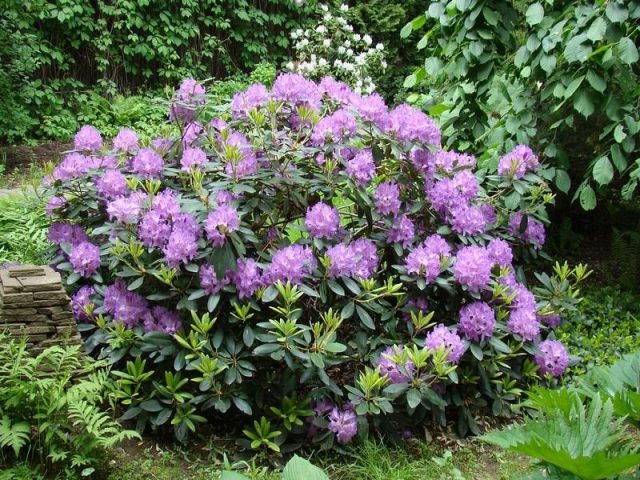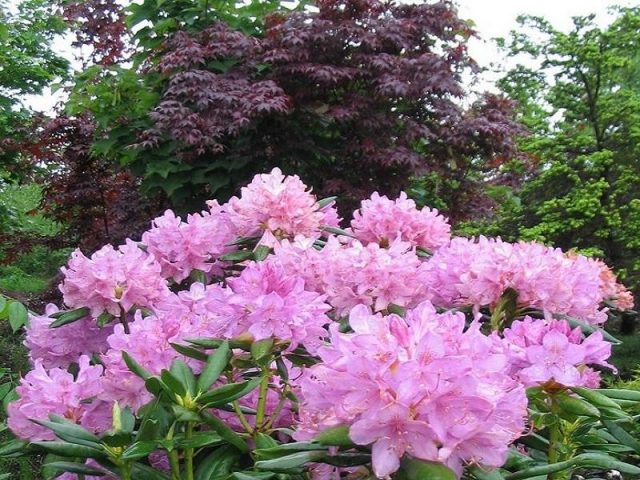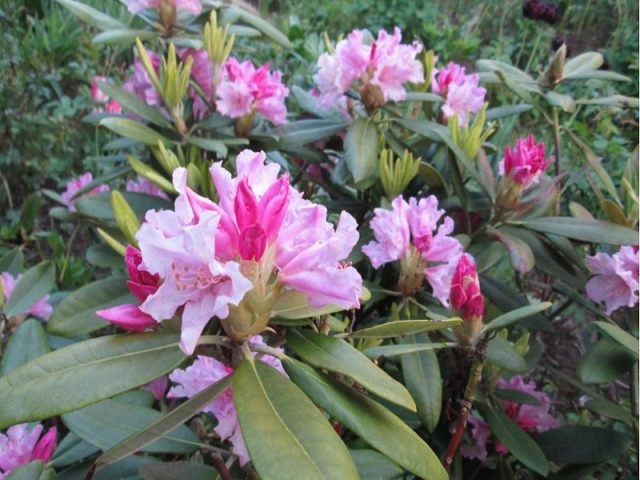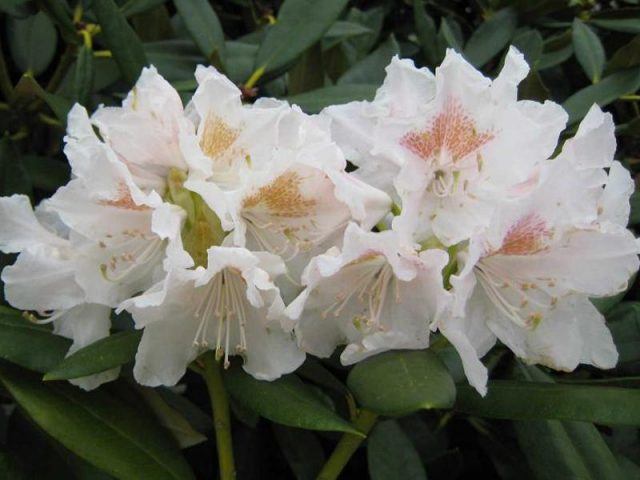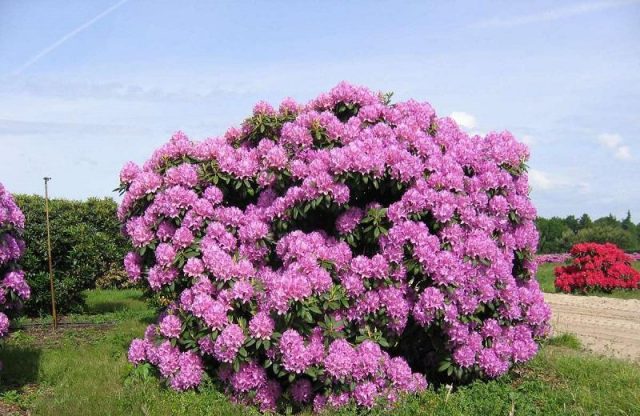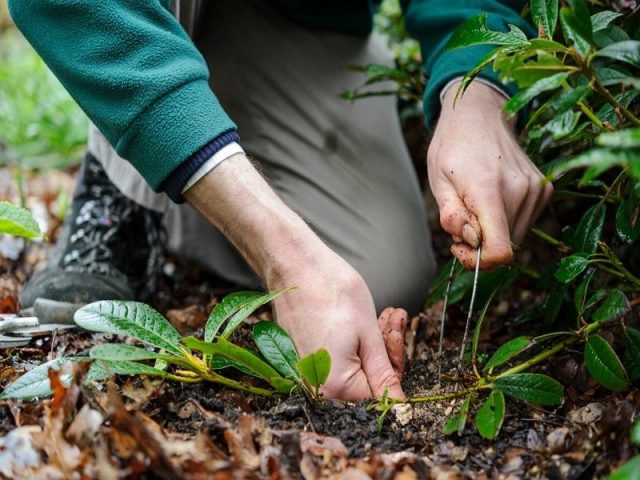Content
Rhododendron catevba, or multiflorous azalea, is not only a beautiful, but also a very resistant plant. It is not afraid of frost, air pollution and the environment. Can decorate garden plots for 100 years of its life. It will not be difficult for a gardener to choose the variety of his choice and grow a magnificent plant. To do this, you should get acquainted with the basic postulates of planting and caring for a large-flowered azalea.
Description of Katevba rhododendron
Evergreen rhododendron catawbiense (rhododendron catawbiense) is a shrub used as a garden plant and the basis in breeding work to create winter-hardy varieties. Its genes are present in many frost-hardy species.
The height of the shrub is up to 4 m, the diameter is slightly larger. At the age of 10, it reaches 1.5 m in height. At the same time, the annual growth is 10 cm.
Young shoots of Katevba rhododendron have tomentose pubescence, later become naked.
The leaves of the plant are elliptical, smooth, with blunt ends, up to 15 cm long and 5 cm wide, with 16 pairs of veins. Their color is dark green, with shine. Petioles - 3 cm.
Twenty large bell-shaped flowers of lilac, purple, violet-red shades are connected in inflorescences. Their pedicels are 3 cm long, covered with hairs. The corolla is 6 cm in diameter and has rounded lobes. The flower has 10 stamens, the column is bare. Flowering lasts about a month. The aroma of the Katevba rhododendron is absent.
Winter hardiness of Katevba rhododendron
Frost resistance allows you to endure winter stresses in the form of precipitation, wind, frost, icing, short-term thaw. Maximum frost resistance is understood as the extremely low values that plants can successfully survive.
The Katevbinsky rhododendron grown in the Moscow region has the properties and advantages of winter-hardy varieties:
- very high frost resistance;
- compactness of the bush;
- branches are hard, not subject to injury under the weight of snow;
- hardening, which allows the flower buds to survive the winter.
Rhododendron Katevbinsky came to Europe from North America, its qualities are used to develop new varieties.
Katevbinsky rhododendron varieties
In order to opt for a specific variety, you can get acquainted with the photo with the Katevba rhododendron and its varieties, or visit a flower exhibition. To begin with, it is worth deciding on the requirements for an azalea: the size of the future plant, its characteristics.
You can choose a variety for every taste.
- If you need a deciduous shrub, then you can opt for the Feuerwerk rhododendron katevba (azalea). It is decorative not only with scarlet flowers, but also with orange leaves in autumn. A plant in September will decorate the garden no less than in summer;
- Large lilac inflorescences will delight gardeners with the Katevba rhododendron Boursault - an evergreen shrub with impressive dimensions: up to 2 m in height and 2.5 m in diameter;
The most popular and beautiful varieties are:
- Roseum Elegance;
- Album;
- Burso;
- Cunninghams White;
- Grandiflorum;
- Nova Zembla.
Rhododendron Katevbinsky Roseum Elegance
The hybrid was obtained in England in the middle of the 19th century. This is an evergreen shrub, reaching a height of 3 m. Every year its shoots increase by 15 cm. The crown of the bushes is dense, dense. Leaves are leathery, shiny, dark green.
Lilac with copper dots inflorescences of 15 buds bloom in June. Flowering continues for two weeks, which, with proper care, can be repeated in autumn.
As you can see in the photo, the Katevba rhododendron Roseum Elegance looks great in single plantings, on lawns, under the canopy of conifers and deciduous plants. The group arrangement is no less impressive. Even a single bush in any corner of the garden looks stylish and elegant.
Rhododendron Katevbin Album
In the description of the Katevba rhododendron Album, it is indicated that it is an evergreen, showy shrub, which has a spherical crown shape, slightly raised, dense. In an adult state, the plant reaches a height of 3 m. Its annual growth is 15 cm. The leaves of the plant are leathery, dark green, long.
Album flowers are extraordinarily beautiful. Their buds are pink, and after blooming - white with a golden mark. Flowering begins early, already in mid-May.
The frost resistance of the culture is good. The foliage needs protection from sunburn during the winter. The plant loves light, but does not tolerate shade well. It is resistant to pests and diseases.
Rhododendron Katevbinsky Album is used for landscaping areas, parks, gardens in combination with other decorative trees and shrubs. The plant looks especially advantageous against the background of conifers.
Rhododendron Katevbin Burso
This is a rather old variety, the year of birth of which is 1849. It is considered to be one of the most hardy.
The hybrid rhododendron Katevba Burso has dark green shiny elliptical leaves, the length of which is 14 cm, width - 5 cm. Abundant flowering of the species begins in June, lasts three weeks. Lilac large flowers are collected in 20 pieces in inflorescences, later turn pink and even turn white. The shrub of the plant is high, up to 4 m, gives large annual growth, loves acidic, drained soil, and does not tolerate waterlogging.
In open spaces, the shrub requires shelter from the winds and the spring sun. Withered inflorescences should be removed so that flower buds are laid next year.
Rhododendron Katevba Burso is very decorative during and after flowering, which is used by flower growers when decorating lawns, lawns, estates, gardens.
Rhododendron Catevbinus Cunninghams White
In Scotland, in the middle of the 19th century, a very elegant variety was bred - Cunninghams White. The Katevba rhododendron bush is small, its height is 2 m, the crown diameter is 1.5 m. The leaves of the shrub are leathery, dark green, light below. Inflorescences are large, white, with a brownish speck on the petal. Flowering lasts about 3 weeks. It is recommended to choose a place for a plant that is quiet, protected from drafts, and shaded. Katevba rhododendron requires increased moisture in dry years. He loves rich soils, but tolerates poor, alkaline soils. The plant has high winter hardiness, provided that the bush is sheltered and the soil is mulched.
Experts recommend using Cunninghams White for non-trimmed hedges. It is possible to plant the culture singly and in groups, in combination and in compositions with other ornamental plants in rose gardens, on terraces, lawns.
Rhododendron Katevbinsky Grandiflorum
This is one of the oldest varieties obtained from selected seedlings of the wild-growing Katevba rhododendron.Evergreen Grandiflorum has a sprawling crown in the shape of a ball, elliptical, leathery, bright green leaves. The shrub is distinguished by its frost resistance, it grows quickly. Its flowering begins in June. Lilac inflorescences with a greenish-yellow spot are large, odorless, contain up to 15 flowers.
Like all heathers, the Katevba rhododendron prefers drained soil, tolerant of poorly lit areas.
Planting and caring for rhododendron katevbinsky
The Katevbinsky rhododendron is one of the most winter-hardy crops. His kidneys can withstand temperatures as low as -25 oS. He is not afraid of thaws and frozen soil in winters with little snow. It is more difficult for a plant to resist under the scorching sun rays in winter and spring. The optimal temperature corridor is from -15 to +25 oC. In the middle lane, it is worth mulching the soil near the Katevba rhododendron and covering it with agrofibre to protect the foliage from burns.
Soil requirements are not high. The main thing is that they are not calcareous, highly sandy or exclusively clayey. Plants will die if their roots are constantly in the water. The best composition for a soil mixture is forest litter, peat and sand.
Planting is carried out in the spring in cloudy weather. The soil must be moist. The earthen ball is soaked in water for a few minutes. The planting pit is made wide, but not deep.
Selection and preparation of the landing site
The choice of location for the Katevbin rhododendron depends on whether it is deciduous or evergreen. The former require a lot of light, they are able to grow in the shade, but they will bloom badly. The latter love shading. All Katevbinsky varieties do not tolerate drafts, drying wind. For their planting, the area near the fence, tall trees is quite suitable. Snow must not be allowed to fall on the bushes from the roof of the house. Since the Katevba rhododendron has superficial roots, birch, linden, willow, maple - plants with the same structure of the root system - should not become its neighbors. Roots grow deep in oak, larch, pine, apple, pear. They can easily coexist without interfering with each other.
Seedling preparation
Katevba rhododendrons tolerate transplantation and change of place better at the age of 3 years. It is worth buying them in a proven nursery, where there is a guarantee of buying a healthy, varietal seedling. It is necessary to inspect it. The leaves and stems of the plant must be healthy, without spots, swelling, damage. It's good when the bush starts branching near the neck.
Before planting the plant, it is recommended to wet the earthen lump well and carefully release it from the container. Sometimes a felt layer of dead roots is found on a coma. It is carefully removed, the seedling is dipped in water and kept in it until the bubbles stop coming out. When the roots and earthy lump are saturated with moisture, you can start planting.
Landing rules
To plant the Katevbinsky rhododendron, several rules must be followed:
- since the roots of the plant are superficial, they spread horizontally, so the width of the planting pit should be twice its depth (30 cm and 60 cm);
- the pit is made much larger than the earthen clod of the seedling;
- a drainage layer of broken brick, pebbles or crushed stone is required;
- the soil mixture is poured onto the drainage with a layer of 10 cm and watered abundantly;
- set the seedling vertically, its root collar should be 5 cm above the ground;
- after the soil settles and the neck drops to ground level, add the substrate, water abundantly;
- then pour a layer of mulch from peat, needles or oak leaves;
- for several days, the Katevba rhododendron should be shaded with a cloth, mesh, and a paper cap.
Watering and feeding
Watering of the Katevba rhododendron is carried out in moderation, with rain or settled warm water.Moisture must penetrate to a depth of at least 30 cm. Faded and dull foliage signals the need for watering. Periodic morning spraying of plants should be carried out to maintain the required air humidity (about 65%). The rate of watering for adult Katevbin rhododendrons is about 10 liters of water under 1 bush three times a week. For young plants, the rate is halved.
Additional watering is necessary in preparation for winter. At this time, the plant is abundantly moistened and the layer of mulch around the bush is increased.
Top dressing should be done several times a season. When planting, trace elements are added to the soil. Nitrogen is added in early spring and before the end of flowering. In the fall, fertilizing with phosphorus and potash fertilizers is carried out.
Pruning
Only if necessary, the Katevba rhododendron bush is pruned. The procedure is performed no more than once every 3 years. The reason may be the need to update the bush, freezing of the shoots.
Most often, pruning for the purpose of formation is not required, since the Katevba rhododendron has a natural shape that is correct and beautiful.
If it is necessary to shorten or cut branches, you should know a few nuances:
- the procedure is carried out until the kidneys swell;
- the cut is made directly above the sleeping kidney, treated with garden pitch;
- some time after pruning, the plant will begin an active growing season, during which the Katevba rhododendron is regularly watered and fed.
In order to rejuvenate a bush or cut out branches that have suffered after wintering, they are shortened at a height of 30 cm from the soil level. To facilitate the restoration of the bush, pruning is carried out within 2 years - half annually.
In order for the deciduous Katevba rhododendron to be thick and voluminous, it is necessary to pinch young shoots in June, remove wilted buds after flowering, and cut out all weakened branches in September.
Preparing for winter
To prepare for the winter period, nitrogen fertilization is stopped in August and switched to potash fertilizers, which allow young shoots to ripen.
Katevbin rhododendrons should be treated with fungicides to prevent fungal diseases.
Winter shelter depends on whether the rhododendron is evergreen or deciduous.
For deciduous species, it will be enough to additionally mulch the soil with needles, leaves, peat. A young plant (up to 3 years old) should be fully covered as evergreen varieties:
- Create a frame from boxes, planks, sticks.
- Cover the root system with mulch from needles, peat.
- Cover with non-woven fabric in several layers over the frame.
- Leave air space between the shelter and the branches.
- Full cover should be carried out after the onset of frost, in November-December.
- From above, the plants are covered with a film after the final onset of winter frosts, leaving the opportunity for airing.
Reproduction
Rhododendron Katevbinsky can be propagated in several ways:
- cuttings;
- layering;
- seeds.
For the first method, cuttings 8 cm long are cut from adult plants, placed in a growth stimulator solution for 12 hours and planted in a mixture of sand and peat, covered with polyethylene. Periodically it is necessary to conduct airing and watering. After 4 months, the cuttings are rooted, after which they are transplanted into a substrate consisting of peat and needles.
Reproduction of Katevba rhododendrons by layering consists in dropping a young shoot, without separating it from the mother plant. After rooting, the seedling is placed in a permanent place.
The third method involves sowing seeds in peat to a depth of 1 cm. After the appearance of several leaves, the seedlings dive into separate containers. They are assigned to a permanent place only in the second year.
Diseases and pests
Despite the resistance of the Katevbinsky rhododendron to diseases, under adverse climatic conditions and violations of the rules of plant care, pathologies can develop:
- tracheomycotic wilting - the roots become brown and rot;
- late blight rot - provokes covering the stems and roots with crimson spots, their rotting, after which the plant withers;
- bacterial cancer - when growths form on the roots, the plant dies;
- rot of buds - the buds of the Katevba rhododendron become brown, and later wither and dry out;
- wax disease - deformation and thickening of the leaves.
Among the pests of rhododendron katevbinsky are most often found:
- furrowed weevil;
- spider mite;
- tobacco thrips;
- rhododendron bug;
- whitefly;
- snails and slugs.
Conclusion
Rhododendron katevbinsky is one of the most beautiful shrubs. The splendor of lush inflorescences ennobles any area, making it cozy, elegant and unique. Frost resistance and unpretentiousness are the conditions for the possible cultivation of plants in many regions of the country.
